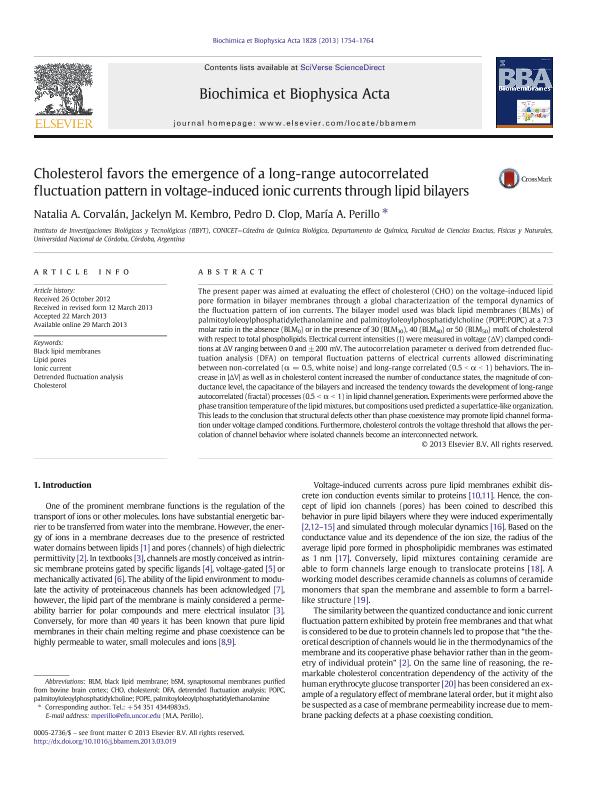Artículo
Cholesterol favors the emergence of a long-range autocorrelated fluctuation pattern in voltage-induced ionic currents through lipid bilayers
Fecha de publicación:
08/2013
Editorial:
Elsevier Science
Revista:
Biochimica et Biophysica Acta - Biomembranes
ISSN:
0005-2736
Idioma:
Inglés
Tipo de recurso:
Artículo publicado
Clasificación temática:
Resumen
The present paper was aimed at evaluating the effect of cholesterol (CHO) on the voltage-induced lipid 22 Q5 pore formation in bilayer membranes through a global characterization of the temporal dynamics of 23 the fluctuation pattern of ion currents. The bilayer model used was black lipid membranes (BLMs) of 24 Q6 palmitoyloleoylphosphatidylethanolamine and palmitoyloleoylphosphatidylcholine (POPE:POPC) at a 7:3 25 molar ratio in the absence (BLM0) or in the presence of 30 (BLM30), 40 (BLM40) or 50 (BLM50) mol% of cholesterol 26 with respect to total phospholipids. Electrical current intensities (I)weremeasured in voltage (ΔV) clamped condi- 27 tions at ΔV ranging between 0 and ±200 mV. The autocorrelation parameter α derived from detrended fluc- 28 tuation analysis (DFA) on temporal fluctuation patterns of electrical currents allowed discriminating 29 between non-correlated (α = 0.5, white noise) and long-range correlated (0.5 b α b 1) behaviors. The in- 30 crease in |ΔV| as well as in cholesterol content increased the number of conductance states, the magnitude of con- 31 ductance level, the capacitance of the bilayers and increased the tendency towards the development of long-range 32 autocorrelated (fractal) processes (0.5 b α b 1) in lipid channel generation. Experimentswere performed above the 33 phase transition temperature of the lipidmixtures, but compositions used predicted a superlattice-like organization. 34 This leads to the conclusion that structural defects other than phase coexistencemay promote lipid channel forma- 35 tion under voltage clamped conditions. Furthermore, cholesterol controls the voltage threshold that allows the per- 36 colation of channel behavior where isolated channels become an interconnected network.
Archivos asociados
Licencia
Identificadores
Colecciones
Articulos(IIBYT)
Articulos de INSTITUTO DE INVESTIGACIONES BIOLOGICAS Y TECNOLOGICAS
Articulos de INSTITUTO DE INVESTIGACIONES BIOLOGICAS Y TECNOLOGICAS
Citación
Corvalán, Natalia Andrea; Kembro, Jackelyn Melissa; Clop, Pedro Diego; Perillo, Maria Angelica; Cholesterol favors the emergence of a long-range autocorrelated fluctuation pattern in voltage-induced ionic currents through lipid bilayers; Elsevier Science; Biochimica et Biophysica Acta - Biomembranes; 1828; 8; 8-2013; 1754-1764
Compartir
Altmétricas




